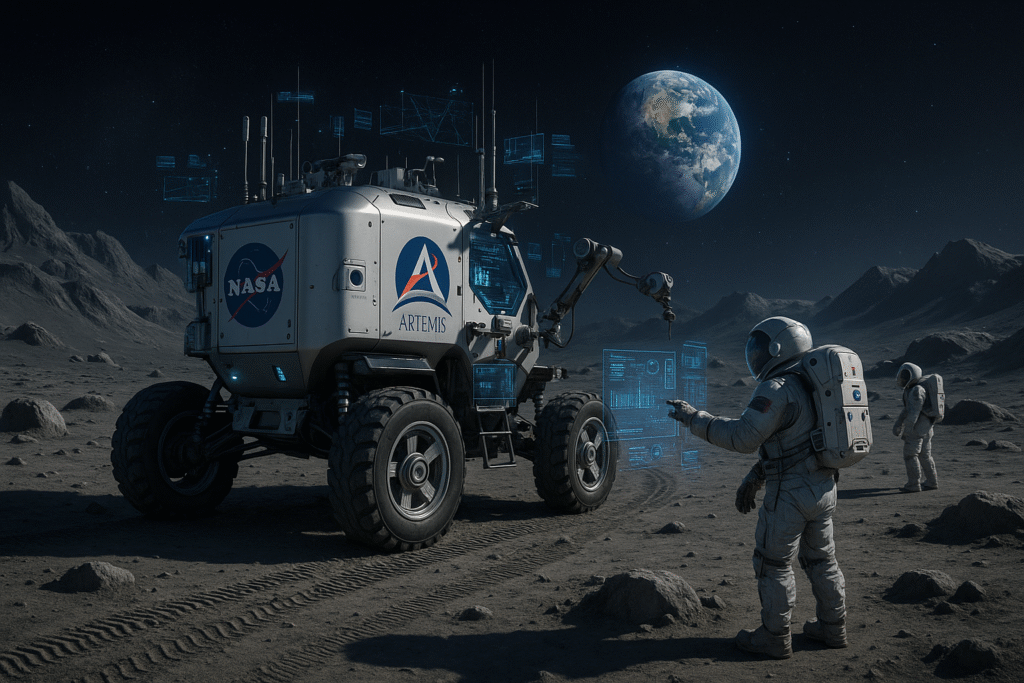Introduction: NASA Prepares for Moon’s Next Giant Leap
NASA’s Artemis program is making headlines again, and this time, it’s all about the next steps in lunar exploration. NASA recently announced a lineup of advanced scientific instruments that will be integrated into the highly anticipated Lunar Terrain Vehicle (LTV). This rover will help astronauts explore the Moon’s surface like never before. If you’re curious about space, technology, or the latest buzz in moon missions, you’ll want to keep reading.

Table of Contents
The Buzz: Why Is “NASA Artemis” Trending?
Before we dive into the nitty-gritty of the new LTV instruments, let’s take a quick look at the online excitement. Searches for “NASA Artemis” are trending on Google and social media, reflecting growing interest in our return to the Moon. People are searching for:
- Artemis launch dates
- Lunar rover technology
- Moon landing updates
- Artemis astronaut selection
- Live NASA events
It’s clear that the dream of exploring the lunar surface still captures the imagination of people across the U.S. and beyond!
What Is the Artemis Lunar Terrain Vehicle?
Think of the Lunar Terrain Vehicle as a high-tech, Moon-ready SUV. It’s designed for astronauts to drive across the harsh and dusty lunar landscape. Unlike the Apollo-era rovers, this vehicle will be loaded with cutting-edge instruments to help collect data, analyze soil, and even scout out potential resources.
Cool Features of the LTV
- Rugged design to handle extreme Moon conditions
- Flexible operation—it can be controlled by astronauts or driven remotely from Earth
- Packed with sensors and science gear for deep exploration
Meet the New Instruments Heading to the Moon
NASA has selected several advanced instruments for the LTV, aimed at helping scientists and astronauts unlock the Moon’s secrets. Here’s what’s coming onboard:
- Regolith Adherence Characterization (RAC) Instrument
Ever wonder how all that Moon dust sticks to everything? The RAC device will study how lunar soil clings to different surfaces. This information is key to developing better space suits and hardware. - Raman Spectrometer for Organic and Mineral Analysis (RSOMA)
Just like a detective collects clues, this instrument will search for organic molecules and unique minerals on the Moon. It may even help us learn more about the Moon’s smoky past! - Lunar Environment Monitoring Station (LEMS)
The Moon might look peaceful, but its surface is actually exposed to a harsh environment. The LEMS will track things like radiation, magnetic fields, and dust movement.
These instruments will not only boost science, but also support the safe and successful return of astronauts—including the first woman and the first person of color to the Moon’s surface as part of the Artemis missions.
Why Do These Upgrades Matter?
Upgrading lunar exploration gear isn’t just about cooler tech—it’s about expanding our knowledge and improving astronaut safety. Imagine driving across a rocky desert at night without headlights, maps, or a weather report. Now, imagine doing that on the Moon, with its unpredictable terrain and extreme temperatures. The LTV’s new instruments will provide:
- Enhanced navigation for accurate mapping and safe movement
- Instant analysis of soil and rocks to spot hazards or resources
- Environmental monitoring to protect astronauts from radiation and dust
With these upgrades, astronauts will be better prepared for unexpected challenges. And who knows what incredible surprises the Moon is hiding?
Social Media Is Watching: Join the Conversation
NASA is not only sharing their progress but inviting questions and involvement online. Recently, NASA tweeted:
Live: The four-person SpaceX Crew-11 mission, including NASA's @AstroIronMike and @Zenanaut, participate in a news briefing on their upcoming launch to the @Space_Station. Questions? Use #AskNASA https://t.co/lTLMK34AeE
— NASA (@NASA) July 10, 2025
NASA’s lively presence on Twitter and other social platforms makes it easy for everyone to stay updated and participate in real time. Remember to check Twitter with hashtags like #NASAArtemis, #MoonMission, or #AskNASA to be part of the conversation!
Looking Ahead: The Artemis Timeline
If you’re wondering what’s next for Artemis, you’re not alone. With each announcement, momentum builds for the upcoming crewed missions. Here’s what to watch for in the coming months:
- Rover assembly and testing at NASA centers
- Further crew announcements, possibly including more “firsts” in space
- Public events leading up to the next lunar launch
Think you’ll ever drive a vehicle on the Moon? While most of us might not get the chance, watching Artemis unfold is the next best thing. Each milestone marks a giant leap for science—and for our shared sense of wonder and adventure.
Conclusion: Why the Artemis LTV Instruments Matter for All of Us
NASA’s introduction of new instruments for the Lunar Terrain Vehicle is more than a technological upgrade—it’s a promise to continue pushing boundaries and making the Moon accessible to future generations. Whether you follow space missions for the science, inspiration, or just for the cool rocket launches, Artemis is proof that curiosity can take us all the way to another world.
Stay tuned, join the excitement online, and keep looking up—because with Artemis, the next #NextGiantLeap is just over the lunar horizon!